In the vibrant food landscape of Taiwan, one dish stands proudly as the unofficial national treasure: beef noodle soup. This hearty bowl brings together tender braised beef, chewy noodles, and a deeply aromatic broth similar to what you might taste in a Din Tai Fung braised beef noodle soup recipe, but made right in your own kitchen. It also carries the story of Taiwan’s complex cultural heritage
Originally influenced by mainland Chinese cuisine, this dish evolved uniquely on the island, becoming a distinct symbol of Taiwanese identity. Beyond its incredible flavor profile, beef noodle soup offers nutritional benefits through its protein-rich meat, bone broth minerals, and vegetable garnishes. What makes this dish truly special is its perfect balance of spices, the melt-in-your-mouth texture of slow-cooked beef, and the way it connects generations of Taiwanese people through food.
Table of Contents
Ingredients for Taiwanese Beef Noodle Soup
Creating authentic Taiwanese beef noodle soup requires a thoughtful blend of ingredients that contribute to its complex flavor profile. Each component plays an essential role in achieving that perfect balance between richness, spice, and umami.
Serious Eats guide to traditional ingredients for a deeper dive.
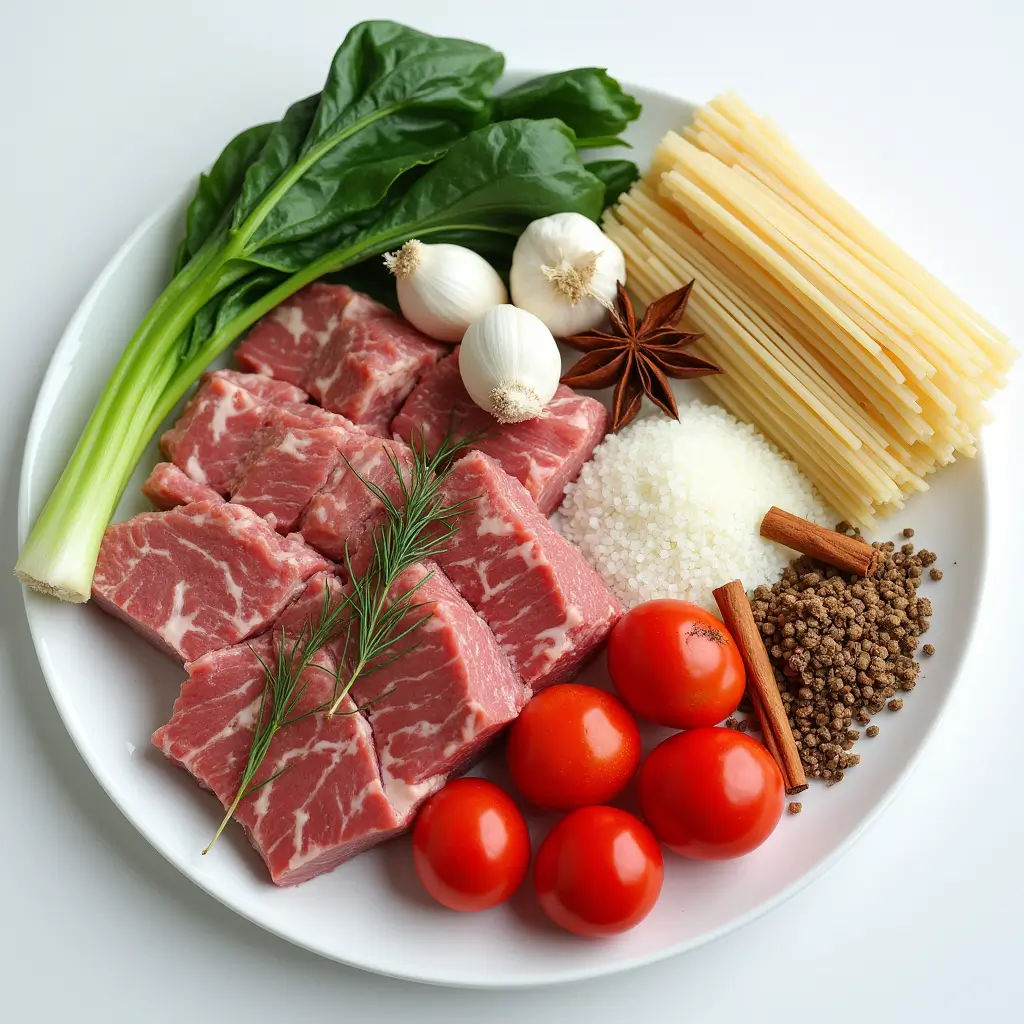
For the Broth and Beef
- 2 pounds beef shank or beef chuck, cut into 2-inch cubes
- 2 tablespoons cooking oil
- 8 cups water or beef stock
- 3 star anise
- 2 cinnamon sticks
- 1 tablespoon Sichuan peppercorns
- 4 bay leaves
- 6 cloves garlic, smashed
- 2-inch piece ginger, sliced
- 2 scallions, white parts only
- 1/4 cup soy sauce
- 2 tablespoons dark soy sauce
- 2 tablespoons doubanjiang (spicy bean paste)
- 1 tablespoon rock sugar or brown sugar
- 2 tomatoes, quartered (optional)
For the Noodles and Garnish
- 1 pound fresh wheat noodles (thick or thin, according to preference)
- 1 cup pickled mustard greens, chopped
- 4 scallions, green parts thinly sliced
- 1/2 cup fresh cilantro leaves
- 2 cups baby bok choy, blanched
- Chili oil, to taste
- White pepper, to taste
Each ingredient contributes a distinct character to the final dish, from the aromatic spices that perfume the broth to the pickled greens that add brightness against the rich beef.
How to Make Taiwanese Beef Noodle Soup
Crafting traditional Taiwanese beef noodle soup requires time and care, but the depth of flavor you achieve makes every step worthwhile. This step-by-step guide will help you create this beloved dish in your own kitchen.
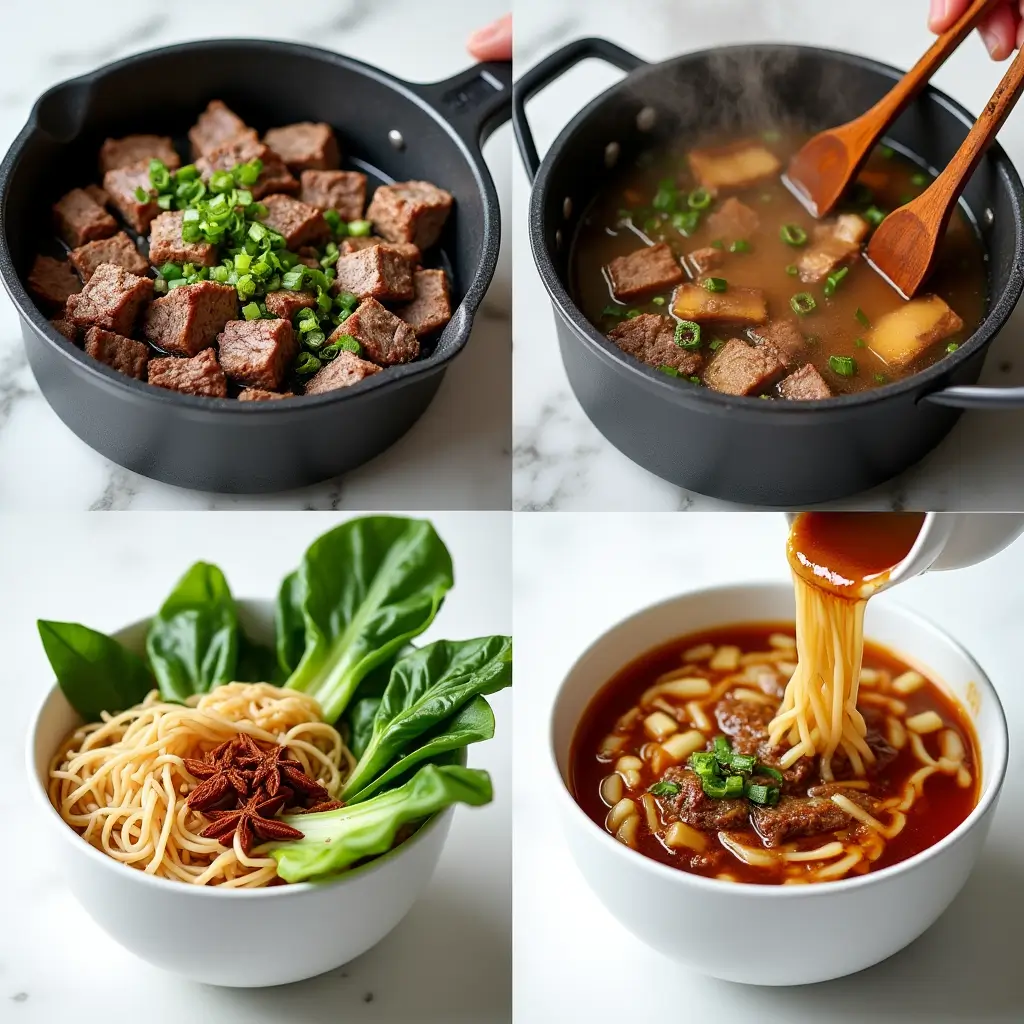
Preparing the Beef
- Heat oil in a large pot over medium-high heat. Pat the beef cubes dry and brown in batches (2–3 minutes per side).
- Return all beef to the pot. Add garlic, ginger, and scallions. Stir until fragrant.
- Add soy sauces and doubanjiang to coat the beef.
- Stir in star anise, cinnamon, Sichuan peppercorns, and bay leaves.
- Add water or stock, tomatoes (optional), and bring to a boil.
- Lower the heat, cover, and simmer for 2–3 hours until beef is tender.
Assembling the Soup
- Cook noodles until al dente.
- Blanch bok choy and shock in ice water.
- Divide noodles into bowls, ladle broth and beef on top.
- Garnish with mustard greens, scallions, cilantro, bok choy.
- Serve with chili oil and white pepper..
How This Recipe Compares to Din Tai Fung’s Famous Bowl
If you’ve ever tasted the iconic Din Tai Fung braised beef noodle soup recipe, you’ll find familiar notes here: the rich soy-based broth, the braised beef that nearly melts apart, and the aromatic spices like star anise and Sichuan peppercorns.
While Din Tai Fung guards its exact recipe, this homemade version mirrors the soul of their dish, comforting, savory, and deeply rooted in tradition yet customizable for your own kitchen.
Serving Suggestions
Taiwanese beef noodle soup isn’t just about the dish itself but also about how it’s presented and enjoyed. The following serving ideas will help you create an authentic Taiwanese dining experience right at home.
Explore authentic Taiwanese side dishes on TasteAtlas.
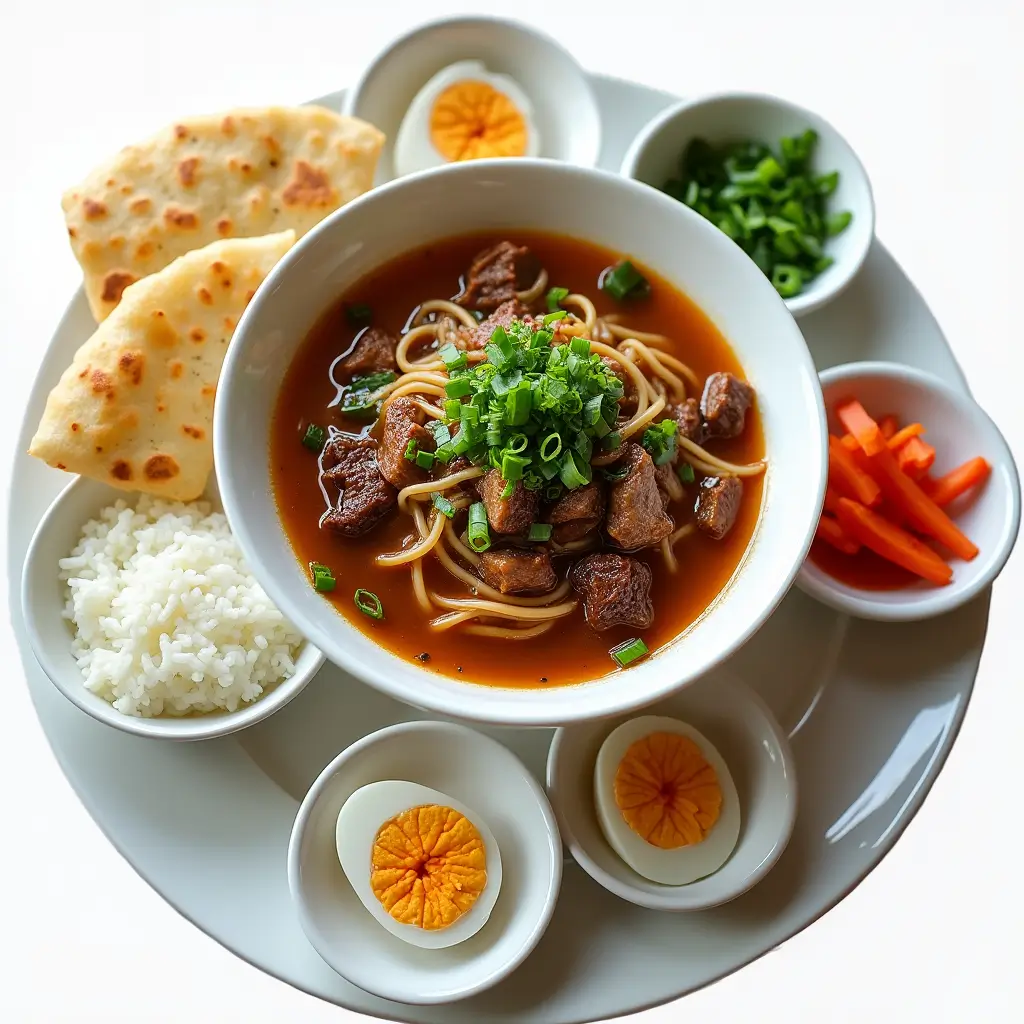
Traditional Accompaniments
The classic way to serve beef noodle soup in Taiwan involves several complementary side dishes. Pickled vegetables are essential their tangy crunch cuts through the richness of the broth. Taiwanese cucumber salad makes a refreshing counterpoint, typically dressed simply with sesame oil, garlic, and a touch of rice vinegar. Many shops in Taipei also serve small dishes of chopped garlic or chili paste on the side, allowing diners to adjust the flavor intensity to their liking.
Creating a Complete Meal
For a traditional Taiwanese meal experience, serve your beef noodle soup alongside:
- Scallion pancakes (cong you bing) – Flaky, layered flatbreads that pair perfectly with the soup
- Century egg tofu – A silky appetizer with preserved duck eggs
- Taiwan beer – The light, crisp national lager complements the rich soup beautifully
- Taiwanese tea eggs – Hard-boiled eggs simmered in tea and spices make a protein-rich side
- Sweet potato leaves – Quickly stir-fried with garlic for a nutritious green element
Many Taiwanese families finish this hearty meal with a light dessert like aiyu jelly or shaved ice to cleanse the palate.
Tips & Variations
Making the perfect Taiwanese beef noodle soup comes with experience, but these insider tips and regional variations will help you master this beloved dish faster and explore its diverse expressions across Taiwan.
Pro Tips for Perfect Results
The secret to truly exceptional beef noodle soup lies in the details. When browning the beef, don’t overcrowd the pot work in small batches to ensure proper caramelization, which builds deeper flavor. For an extra-rich broth, add beef bones alongside your meat cuts. Some Taipei masters simmer their broth for up to 8 hours.
Pre-soak Sichuan peppercorns in warm water for 10 minutes, then dry before toasting to maximize their citrusy, numbing quality. If doubanjiang isn’t available, you can replicate its flavor by blending miso paste with a bit of chili sauce. Fresh noodles make a significant difference, but if using dried, choose ones with high wheat content for authentic chewiness.
Regional Variations
Taiwan’s beef noodle soup varies remarkably across the island:
- Clear Broth (Qing Dun) – Popular in southern Taiwan, featuring a lighter, non-spicy broth with more ginger and rice wine
- Tomato Beef Noodle Soup – A modern Taipei variation adding fresh tomatoes for subtle sweetness and acidity
- Five-Spice Beef Noodle Soup – Common in central Taiwan, with a pronounced five-spice powder profile
- Tainan-Style – Incorporates more medicinal herbs like angelica root and licorice
Many home cooks create their own signature versions, adding ingredients like tendon for textural contrast or daikon for sweetness.
Nutritional Information for Taiwanese Beef Noodle Soup
While Taiwanese beef noodle soup is primarily celebrated for its incredible flavor, it also offers several nutritional benefits that make it more than just a delicious comfort food.
Macronutrient Profile
A typical bowl of Taiwanese beef noodle soup contains approximately:
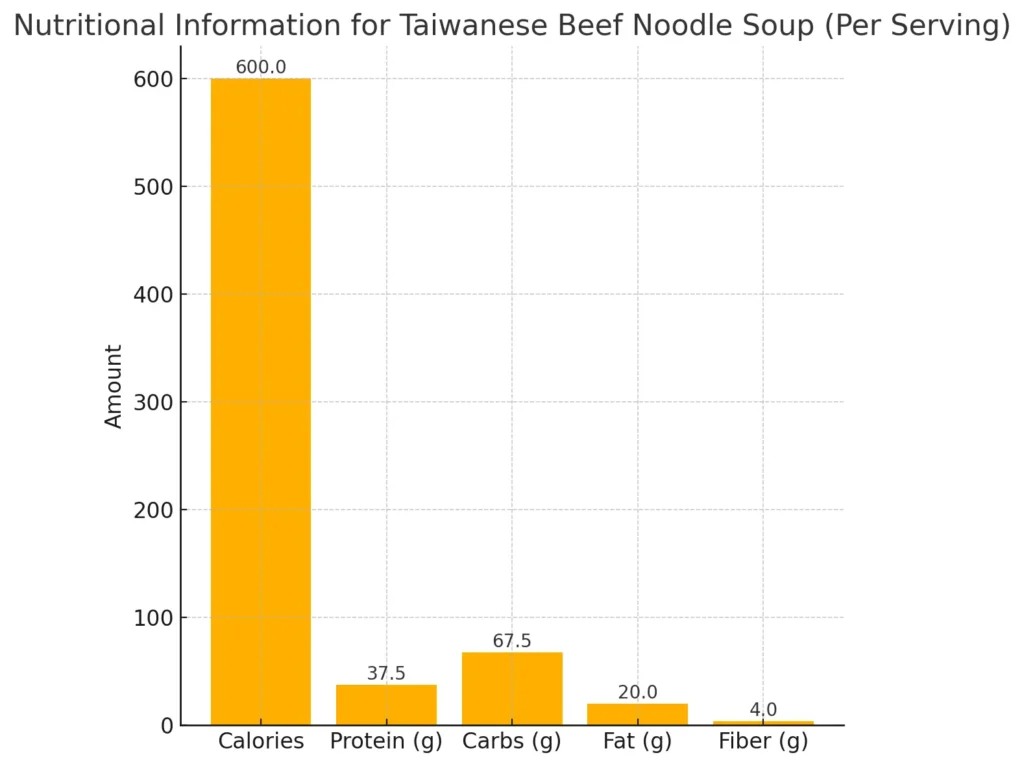
- Calories: 550-650 per serving
- Protein: 35-40g (primarily from beef)
- Carbohydrates: 60-75g (mainly from noodles)
- Fat: 15-25g (from beef and cooking oil)
- Fiber: 3-5g (from vegetables and garnishes)
This soup delivers a well-rounded meal, with beef offering a hearty source of protein to help maintain muscle and keep you full, while the wheat noodles supply lasting energy through complex carbohydrates.
Micronutrients and Benefits
This national dish delivers impressive micronutrient content:
- Iron: The beef provides heme iron, which is highly bioavailable
- Zinc: Essential for immune function, abundant in beef
- B vitamins: Particularly B12 from the meat, supporting nervous system health
- Vitamin C: Present in the vegetable garnishes
- Minerals: The long-simmered bone broth releases calcium, magnesium, and phosphorus
The spices and aromatics like ginger, garlic, and star anise also contain compounds with anti-inflammatory properties.
See an expert nutritional breakdown on Healthline’s bone broth benefits.
FAQs
What can I eat as a raw vegan?
As a raw vegan visiting Taiwan, you’ll find fresh options at local markets. Look for fruit stands selling tropical varieties like guava, wax apples, and dragon fruit. Many night markets offer fresh juices and salads. Consider visiting specialized raw vegan cafés in Taipei that prepare zucchini noodles, vegetable wraps, and coconut-based desserts. Traditional Taiwanese bubble tea shops often provide fruit teas that can be ordered without the dairy components.
What is Taiwan’s famous food?
Taiwan boasts many famous dishes beyond beef noodle soup. Originating in Taiwan, bubble tea has grown into a worldwide sensation. Xiaolongbao (soup dumplings) from Din Tai Fung have international acclaim. Gua bao, or “Taiwanese hamburgers,” feature tender pork belly in steamed buns. Stinky tofu, despite its strong aroma, is a beloved street food. Oyster omelets, three-cup chicken, and shaved ice desserts are other iconic Taiwanese specialties found throughout the island’s vibrant night markets.
What is Taiwan’s national dish?
Beef noodle soup is widely regarded as Taiwan’s unofficial national dish. This status was solidified when Taipei began hosting annual beef noodle festivals and competitions in the 1990s. The dish represents Taiwan’s complex cultural heritage and has become a source of culinary pride nationally. Its popularity spans all regions of Taiwan and crosses socioeconomic boundaries, making it truly representative of Taiwanese identity.
Is Taiwanese food different from Chinese food?
Yes, Taiwanese cuisine is distinct from mainland Chinese food, though they share historical connections. Taiwanese food typically features lighter flavors, more seafood, and unique preservation techniques influenced by the island’s subtropical climate. While mainland Chinese culinary traditions form the foundation, Taiwanese cuisine incorporates Japanese influences from the colonial period and indigenous ingredients. Taiwanese cooking often emphasizes fresh ingredients and subtle seasonings compared to some bolder regional Chinese cuisines.
Is Taiwanese the same as Thai food?
No, Taiwanese and Thai cuisines are entirely different. Thailand’s food is characterized by bold flavors balancing sweet, sour, salty, and spicy elements, with ingredients like lemongrass, galangal, and coconut milk. Taiwanese cuisine stems from Chinese culinary traditions with Japanese and local indigenous influences, featuring more subtle flavors, abundant seafood, braised dishes, and distinctive street foods. The two cuisines represent different cultural histories, geographic influences, and flavor profiles.
Is this similar to Din Tai Fung’s recipe?
It’s inspired by their style. While exact proportions are secret, this homemade version captures the essence.
What is Taiwan’s national dish?
Taiwanese beef noodle soup is widely regarded as the unofficial national dish.
Is Taiwanese food different from Chinese or Thai food?
Yes. Taiwanese food is influenced by Chinese cuisine but has evolved with unique flavors and local ingredients. It’s not related to Thai cuisine.
Conclusion & Call to Action
Taiwanese beef noodle soup stands as more than just a meal, it represents the heart of Taiwan’s rich culinary heritage.
If you’re a fan of iconic bowls like the Din Tai Fung braised beef noodle soup recipe, this version will satisfy your craving and bring a taste of Taiwan to your home.
👩🍳 Tried it? Snap a photo, tag us, or leave a comment!
📤 Share this recipe with foodies looking for global comfort dishes.

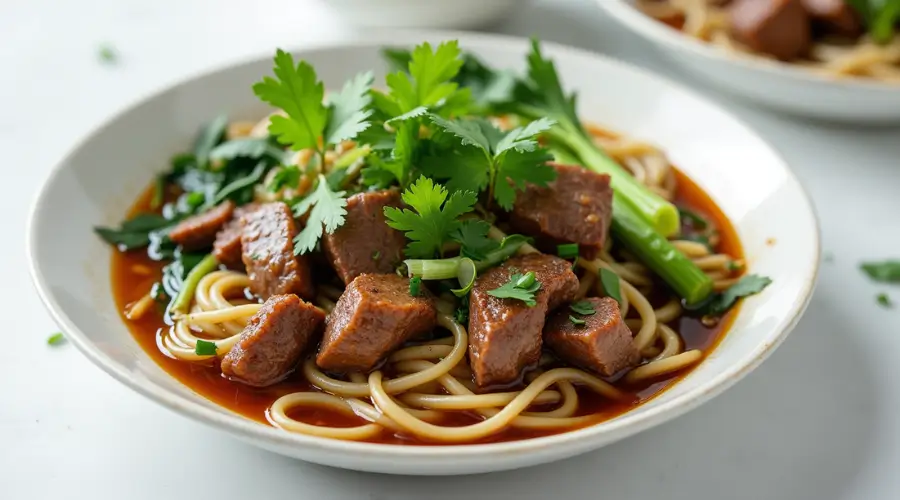
1 thought on “Taiwanese Beef Noodle Soup: A Bold Taste of Tradition”